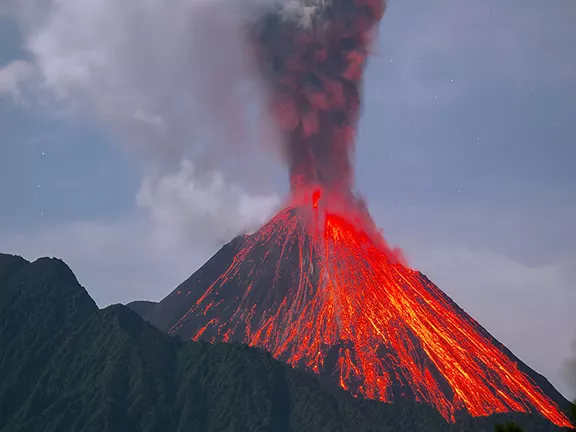Climatic Events that Changed the World
The 3.2k-Year BP Event: A Climatic Shift and its Impact on Ancient Civilizations
This article explores the 3.2k-year BP (Before Present) climatic event, a significant period of drought and environmental change around 1200 BC. We will examine the evidence for this event, its potential causes, and how various ancient civilizations in the Mediterranean and Near East responded. Our focus is on the human response to this climatic stress, rather than definitively attributing the Bronze Age Collapse to this single event.
By Nick Nutter on 2024-02-20 | Last Updated 2025-05-21 | Climatic Events that Changed the World
This article has been visited 7,337 times

Lebanon Landscape after 1200 BC
What Was the 3.2k-Year BP Event?
The 3.2k-year BP event refers to a rapid decline in rainfall across parts of the eastern Mediterranean, lasting for up to 300 years around 1200 BC. This period caused what some researchers have labeled a "megadrought" in certain regions.
Uncovering the Evidence: The 1200 BC Megadrought
In the past two decades, extensive research has solidified the evidence for a significant climatic event around 1200 BC.
Palynologists (pollen experts) in Syria, Israel, Egypt, and Cyprus have found evidence of widespread environmental stress.
Speleologists (those who study cave formations like stalagmites and stalactites) in Greece and Israel have analyzed growth rings that indicate changes in precipitation.
Paleolimnologists (researchers who reconstruct lake histories from deposits) in Turkey, Syria, and Iran have provided further data supporting a prolonged dry period.
Collectively, this body of work strongly suggests that the eastern Mediterranean experienced a severe drought around 1200 BC. While some studies initially termed it a "megadrought," further analysis indicates the drought likely lasted between 150 and 300 years. Some research suggests it occurred in two phases: an initial drought between 1250 and 1150 BC, a brief return to normal rainfall for about 50 years, and then another drought from 1100 to 950 BC (possibly extending to 850 BC).
Further supporting the climatic shift, a separate study on sea surface temperatures revealed a sharp increase in atmospheric temperatures in the Northern Hemisphere just before 1225 BC, followed by a rapid decrease in temperatures and a decline in Mediterranean Sea surface temperatures before 1190 BC.
Connecting Climate to Collapse: The Bronze Age and the 3.2k Event
The 3.2k-year BP event notably coincides with the collapse of Bronze Age civilizations in the Near East. Archaeologists first proposed a connection between climate and this societal upheaval in the late 19th century. More recently, renewed interest in climate change has led some to view the 3.2k-year BP event as a primary cause, or at least a significant contributing factor, to the Bronze Age Collapse.
However, this article focuses on documenting the human responses to climatic events. We will not attempt to quantify the precise role of the 3.2k-year BP event in the Bronze Age collapse, but rather explore the observable reactions of various societies.
Do you enjoy my articles? For your reading pleasure, this website does not carry third party ads. You could help me write more articles by buying me a cup of coffee.
What Caused the 3.2k-Year BP Event?


3.2k yr BP event
The precise cause of this prolonged drought remains a subject of ongoing scientific debate, with several compelling, and not necessarily mutually exclusive, theories:
Volcanic Eruption (Mount Etna): One theory suggests that the volcanic eruption of Mount Etna around 1300 BC may have triggered the climate change.
Solar Minimum: Another hypothesis proposes a decline in solar output during this period, leading to a "solar minimum." This would have had global effects, not just regional. Supporting this, research indicates that air pollution—likely from a volcanic eruption (though the specific volcano and exact timing are disputed)—restricted sunlight for about twenty years until 1140 BC, impacting global tree ring growth and agricultural production.
Bond Event: An increase in ice-rafted debris in the North Atlantic, penetrating further south and west than usual, could have caused a decline in ocean surface temperatures and reduced precipitation. This sequence of events, known as a Bond Event, occurs roughly every 1,500 years.
Rapid Climate Changes (RCCs): These events, occurring approximately every 1,450 years, involve frigid Arctic air moving into the Aegean region. This can cause a 2-3 degree Celsius drop in sea surface temperatures in the southeastern Aegean, leading to arid conditions. One such event is identified between 1100 and 900 BC.
Written Accounts of Drought and Famine
Fortunately, many Bronze Age civilizations in the Near East produced written records and corresponded with each other. Numerous tablets and inscriptions discovered in the Levant, Anatolia, Mesopotamia, and Egypt offer direct evidence of drought-induced famine.
Hittite Empire: Between 1279 and 1213 BC, Hittite Queen Puduhepa wrote to Egyptian Pharaoh Ramesses II, stating, "I have no grains in my lands." This led to a trade embassy seeking barley and wheat from Egypt. Later, between 1213 and 1203 BC, Pharaoh Merneptah recorded sending grain by ship "to keep alive this land of Hatti," an early example of famine relief. A letter from the Hittite king to the king of Ugarit in the 13th century BC dramatically inquires about a shipment of 2,000 units of grain (up to 450 tons), ending with "It is a matter of life or death."
Ugarit and Emar: Just before its destruction in 1185 BC, a letter from Emar in Syria to Ugarit pleaded, "There is famine in our house, we will all die of hunger. If you do not quickly arrive here, we ourselves will die of hunger." Even Ugarit suffered, as Pharaoh Merneptah's reply to the king of Ugarit confirms: "So you had written to me, in the land of Ugarit there is severe hunger. May my lord save the land of Ugarit and may the king give grain to save my life and to save the citizens of the land of Ugarit."
Egypt: Food rationing was implemented in the final years of Ramesses III's reign (1184-1155 BC), a period that also saw the world's first recorded labor strike due to unprovisioned food rations for royal tomb-builders and artisans at Deir el Medina. This raises questions about the fate of the lower classes during this stressful time.
These written accounts provide powerful direct evidence of the widespread impact of drought and food shortages across the eastern Mediterranean during the period of the 3.2k-year BP event.
The Ancient Near East and Mediterranean circa 1300 BC


The Ancient Near East about 1300 BC
The period between the 4.2k-year BP event (around 2200 BC) and 1300 BC saw a remarkable recovery and flourishing of societies in the ancient Near East. By 1300 BC, the region had coalesced into six major powers: the Mycenaean Civilization, the Hittite Empire, the Middle Assyrian Kingdom, the Middle Babylonian Kingdom, the Middle Elamite Kingdom, and the Egyptian New Kingdom. This was a dynamic era, with empires vying for territory. Societies in Spain, France, Italy, and the major Mediterranean islands also evolved significantly during this time.
Advancements from previous periods, such as the chariot (circa 2000 BC), glass manufacturing in Egypt (circa 1500 BC), and the seed drill in Mesopotamia (circa 1500 BC), contributed to this rapid recovery. Mycenaean Greece also saw the invention of concrete after 1400 BC.
Let us examine how various civilizations in these regions fared during the 3.2k-year BP event.
The Mycenaean Civilization (Southern Greece, Aegean Islands, Crete)
By 1300 BC, the Mycenaean Civilization encompassed southern Greece, the southern Aegean islands, Crete, and a small part of southwestern Anatolia. This region experienced significant disruption around 1200 BC.
Mainland Greece: Thebes was burned around 1250 BC, potentially leading to an attack on Gla and the abandonment of Orchomenos. Mycenae itself was attacked, prompting the construction of defensive "Cyclopean Walls" at Athens, Tiryns, Midea, and Mycenae. A second wave of destruction around 1190 BC marked the end of the Mycenaean Civilization at Mycenae. Up to 50% of the population migrated to Cyprus and the Levantine coast. While some areas like Athens were never destroyed, and Tiryns even expanded in the 11th century BC, most of the former Mycenaean territory saw populations disperse into scattered thatched houses.
Crete: Minoan palaces like Malia, Phaestos, and Zakros were destroyed around 1450 BC, leaving Knossos as the sole surviving palace. The Mycenaeans then imposed their administration. Knossos palace was destroyed around 1350 BC, though the town continued to be occupied and even saw a resurgence after 1200 BC.
It's important to note that the fall of the Minoan and Mycenaean civilizations appears to be largely driven by human actions and internal conflicts, with little direct evidence linking it to climate fluctuations or palatial overexploitation of the landscape.
The Hittite Empire (Anatolia, Northern Levant, Cyprus)
The Hittite Empire, with its vassal cities, controlled Anatolia, western Syria, the northern Levantine coast, and Cyprus. They were in constant conflict with the Middle Assyrian Empire for territory in the northern Levant.
Anatolia: The Hittite Empire disintegrated, with its capital Hattusa falling in 1190 BC to the Kaskas tribe from northern Anatolia. Other Anatolian cities like Karaoglan, Alaca Hoyuk, Alishar, Masat Hoyuk, Mersin, and Tarsus were also destroyed around this time.
Northern Levant and Cyprus: Cities along the northern Levantine coast, including Ugarit (around 1182 BC), experienced destruction around 1200 BC. Similarly, Cypriot cities saw destruction. While these events coincided with the 3.2k-year BP event, direct causation by climatic change is not clear, and many destroyed cities recovered relatively quickly.
The empire fragmented into independent city-states, eventually absorbed by the expanding Middle Assyrian Empire. The extent to which climatic events contributed to this disintegration is debated. However, the previously mentioned Hittite pleas for grain to alleviate famine (1279-1203 BC) suggest that prolonged famine could have caused social unrest and weakened the central monarchy, potentially allowing groups like the Kaskas to expand.
Troy: The legendary city of Troy (Walusa) in northwestern Anatolia experienced multiple destruction layers throughout its history. A destruction layer dated to 1180 BC shows evidence of an attack, making it a likely inspiration for the Trojan War narratives.
The Middle Assyrian Empire (Northern Iraq, Northeastern Syria)
The Middle Assyrian Empire, centered in northern Iraq, expanded into northern Syria in the late 13th and early 12th centuries BC, even making Babylonia a vassal state.
Despite the widespread disruptions, the Middle Assyrian Empire appears largely untouched by the 3.2k-year BP event. While the 12th century BC saw some instability with weak reigns and local rebellions, leading to the loss of some conquered territories, there is no evidence of major destructions in their main cities.
The Middle Babylonian Period (Iraq, Syria, Western Iran)
The Middle Babylonian territory spanned the Euphrates and Tigris rivers, encompassing eastern Iraq, parts of Syria, and western Iran. During the late 13th and early 12th centuries BC, Babylon was ruled by the Kassites.
In 1158 BC, the Elamites, led by Shutruk-Nahhunte, invaded and destroyed Babylon, claiming the Kassite throne. There is no evidence suggesting that climatic factors motivated these actions.
The Egyptian New Kingdom (Nile Delta, Nile Valley, Southern Levant)
The Egyptian New Kingdom (1550-1069 BC), Egypt's third "Golden Age," reached its peak power during this period. However, after the death of Ramesses II in 1213 BC, it entered a period of decline marked by foreign invasions and ineffective pharaohs.
Ramesses III briefly restored prestige by defeating the "Sea People" and defending against Libyan incursions. Yet, upon his death in 1155 BC, bickering heirs oversaw the empire's fragmentation into the divided Egypt of the Third Intermediate Period. While Egypt's control of the southern Levant waned during the 12th century BC, with outposts and temples being lost, these destructions are attributed more to Hittite expansion than direct climatic events.
Iberian Peninsula (Southwest Iberia)
The El Argar society in southwest Iberia emerged after the disappearance of the Los Millares society around 2200 BC. This hierarchical society, centered on the border of Murcia and Almeria, controlled grain and metal distribution from unfortified settlements that often included cisterns—a clear response to increasing aridity. Their diet was primarily barley, with lower classes showing signs of malnutrition. The El Argar society vanishes from the archaeological record around 1500 BC.
Similarly, the Motilla settlements in La Mancha and the large enclosure at Valentina de la Concepcion fell into disuse around this time, as did megalithic dolmens in Huelva and Granada. The dispersal of populations from nucleated settlements suggests shortages and a breakdown of central control, possibly due to increased aridification. However, these events predate the 3.2k-year BP event by three hundred years, likely reflecting a gradual increase in aridity due to the continued southerly drift of the tropical rain belt.
Southern France (Mediterranean Coast)
Populations along the Mediterranean coast of France appear to have been largely unaffected by the climatic events discussed. Their subsistence combined farming and hunting. The fortified settlement of Camp de Laure near the Rhone river mouth, established around 1650 BC, and nearby scattered farmsteads, show no discernible changes and survived beyond 1200 BC.
Corsica and Sardinia
Sardinia: Around 1800 BC, the construction of large stone towers called nuraghi began, with their numbers and size increasing exponentially for 200 years. Over 8,000 such towers, up to twenty meters tall, sprang up across the island. Megalithic burial mounds evolved into elongated "Giants Tombs" with ceremonial forecourts. Nuraghi construction ceased around 1150 BC, with some being dismantled. Collective burials in Giants Tombs also ended, replaced by individual tombs. Some scholars suggest the emergence of village-level "parliaments" during this time.Corsica: Around 1800 BC, Bronze Age communities on Corsica began building smaller towers called torri, giving the name to the Torrean culture. This culture seamlessly evolved from the previous megalithic culture.
After 1150 BC, a new warrior society emerged on both islands, depicted in statue menhirs with horned helmets, round shields, and Mycenaean-style daggers. This suggests increasing instability and conflict in the eastern Mediterranean, rather than direct climatic impact, as a primary driver of these changes.
Apennine Peninsula (Northern Italy)
In northern Italy, the Terramare culture developed on the Po delta and plain after 1700 BC. This area, previously marshland, became fertile due to increasing regional aridity. The Terramares were hunters, pastoralists, and agriculturists, cultivating beans, grapes, wheat, and flax. They lived in sixty small, quadrangular villages, each surrounded by an earth bank and moat.
Archaeological evidence suggests a population boom to around 200,000, a number that became unsustainable after a series of droughts between 1300 and 1200 BC. Evidence of social unrest, internal disputes, and raiding (skeletons with axe wounds, swords, and arrowheads in abandoned villages) could have been exacerbated by a final drought around 1200 BC. By 1150 BC, all villages were abandoned, and the population dispersed to southern Italy, Sicily, and the Aegean.
Conclusion: The 3.2k-Year BP Event – A Contributory Factor, Not the Sole Cause
While the 3.2k-year BP event represents a significant climatic shift, attributing the rise and fall of these diverse civilizations solely to this event is overly simplistic.
Central Levantine Coast:: Major sites like Sidon, Tyre, Arwad, and Byblos show no discontinuity of occupation between the 13th and 11th centuries BC, indicating a negligible impact from the 3.2k-year BP event.
Mycenaean World:: While some population dispersal occurred, it's unclear whether this was primarily due to climate change, drought, or other human factors like conflict.
Egypt and the Southern Levant: : Egypt's waning control of the southern Levant in the 12th century BC is more attributable to Hittite expansion than direct climatic events.
Middle Assyrian Kingdom: : This empire largely expanded during the drought period, only losing territory towards its end, suggesting it was not critically impacted.
Hittite Empire: : The pleading letters about drought do suggest the 3.2k-year BP event was a contributing factor to its downfall. However, the Hittites also faced numerous external competitors, and the empire's disintegration was multifaceted.
Apennine Peninsula: : Only here do we find strong evidence of violence and total dispersal directly linked to the 3.2k-year BP event, with the Terramare culture's collapse.
Corsica and Sardinia: The shift to a warrior society after 1150 BC, marked by changes in building practices and burial customs, suggests a reaction to increasing instability in the eastern Mediterranean, not necessarily a direct climatic impact.
The 3.2k-year BP event was a significant "glitch" in Mediterranean weather patterns, but it followed a millennium of increasing aridity and periodic droughts since the 4.2k-year BP event. This can be seen as part of normal Mediterranean weather behavior, with fluctuating precipitation patterns. Throughout this thousand-year period, civilizations had learned to cope with periodic droughts.
Therefore, the 3.2k-year BP event should be viewed as a contributory factor to the broader Bronze Age collapse, rather than its sole or apocalyptic cause. It likely intensified existing stresses and vulnerabilities within these complex societies, playing a role in their ultimate fate. Subsequent articles will delve deeper into the multifaceted reasons behind the general collapse of Bronze Age civilizations.
References
Bernhardt, C.E.B.P. Horton and J.D. Stanley. (2012). Nile delta Vegetation Response to Holocene Climate Variability. Geology 40/7: 615 - 18.
Bond, G. et al. (1997) A Pervasive Millennial Scale Cycle in North Atlantic Holocene and Glacial Climates. Science 278: 125 - 66.
Broodbank, C. (2013). The Making of the Middle Sea. Thames & Hudson Ltd.
Drake, B.I. (2012) The Influence of Climatic Change on the Late Bronze Age Collapse and the Greek Dark Ages. Journal of Archaeological Science 39: 1862 - 70.
Finkelstein I.E. Arie, M.A.S. Martin and E. Piasettzky. (2017) New Evidence on the Late Bronze/Iron 1 Transition at Megiddo. Implications for the End of the Egyptian Rule and the Appearance of Philistine Pottery. Egypt and the Levant 27, 249 - 259.
Kaniewski, D., Luterbacher, J., Piotrowska, N., Rajchel, J., Sobolewski, P., Slonoswski, M., Terzolas, B., Trifonova, E. (2013). Environmental reconstruction for the medieval Balkans using multiple proxies. Climate of the Past, 9(6), 2481-2492.
Kaniewski, D., Van Campo, E., Le Goff, H., Ghaleb, D., Marriner, N. (2014). Sea-level rise, coastal change and early human settlements in the Mediterranean basin. The Holocene, 24(2), 200-216.
Kaniewski, D., Djamali, M., Pessart, A., Brahim, A., El Faiz, M., Guiot, J. (2015). Holocene climate variability in the eastern Mediterranean (Lebanon): reconstruction and regional context. Quaternary Science Reviews, 120, 10-22. Link to abstract: https://doi.org/10.1016/j.quascirev.2015.03.009
Kaniewski, David & Joel, Guiot & Campo, Elise. (2015). Drought and societal collapse 3200years ago in the Eastern Mediterranean: A review. Wiley Interdisciplinary Reviews: Climate Change. 6. 10.1002/wcc.345.
Kaniewski, D., Van Campo, E., BouDaoud, A., Guiot, J., Ghaleb, D., Marriner, N. (2019). High-resolution Bronze Age palaeoenvironmental change in the Eastern Mediterranean: exploring the links between climate and societies. Quaternary Science Reviews, 219, 255-272. Link to abstract: https://doi.org/10.1016/j.quascirev.2019.05.020
Kaniewski, D., Marriner, N., Cheddadi, R., Fischer, P.M., Otto, T., Luce, F., Van Campo, E. (2020). Climate Change and Social Unrest: A 6000-Year Chronicle From the Eastern Mediterranean. Geophysical Research Letters, 47(23). Link to abstract: https://agupubs.onlinelibrary.wiley.com/doi/abs/10.1029/2020GL087496
Cline, E.H. (2021). 1177 The Year Civilization Collapsed. Princeton University Press.
Mackli, M.G. et al. (2015). A New Model of River Dynamics, Hydroclimatic Change and Humans Settlement In the Nile Valley Derived from Meta-Analysis of the Holocene Fluvial Archive. Quaternary Science Reviews 130: 109 - 23.
Roberts N. et al. (2016). A Tale of Two Lakes: A Multi Proxy Comparison of Late Glacial and Holocene Environmental Change in Cappadocia, Turkey. Journal of Quaternery Science 31/4: 348 - 62.
Weberg, E. and Finne, M. (2018) Resilience and Persistance of Ancient Societies in the Face of Climate Change. A Case Study from Late Bronze Age Peloponnese. World Archaeology 50/4: 584 - 602.
Weis B, (1982) The Decline of Late Bronze Civilization as a Possible Response to Climate Change. Climate Change 4: 173 - 178.
Weninger, B. et al. (2009). The Impact of Rapid Climate Change on Prehistoric Societies During the Holocene in the Eastern Mediterranean. Documenta Praehistorica 36.
Image Credits
Image 1:. The Ancient Near East c 1300 BC. A map illustrating the changing balance of power in the Ancient Near East in the 13th century BCE resulting from the expansion of the Hittite and Assyrian empires and the collapse of the Mittani kingdom. Uploaded by Simeon Netchev, published on 15 November 2021.
Do you enjoy my articles? For your reading pleasure, this website does not carry third party ads. You could help me write more articles by buying me a cup of coffee.
 1: Climatic Events
1: Climatic Events 2: The 8.2k yr BP event
2: The 8.2k yr BP event 3: Creating the Sahara
3: Creating the Sahara 4: The 4.2k yr BP event
4: The 4.2k yr BP event